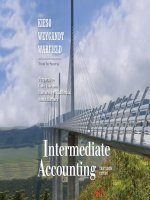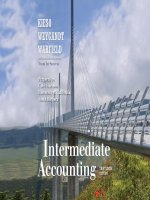Intermediate accounting 15e kieso warfield chapter 20
Bạn đang xem bản rút gọn của tài liệu. Xem và tải ngay bản đầy đủ của tài liệu tại đây (1.56 MB, 78 trang )
INTERMEDIATE
Intermediat
ACCOUNTING
Intermediat
e
e
Accounting
Accounting
F I F T E E N T H
20-1
E D I T I O N
Prepared by
Coby Harmon
Prepared by
Prepared by
University of California,
Barbara
CobySanta
Harmon
Harmon
Westmont
College SantaCoby
University
of California,
Barbara
University of California, Santa Barbara
Westmont College
kieso
weygandt
warfield
team for success
PREVIEW OF CHAPTER 20
Intermediate Accounting
15th Edition
Kieso Weygandt Warfield
20-2
20
Accounting for Pensions
and Postretirement
Benefits
LEARNING OBJECTIVES
After studying this chapter, you should be able to:
1.
2.
3.
Distinguish between accounting for the
employer’s pension plan and accounting
for the pension fund.
Identify types of pension plans and their
characteristics.
Explain alternative measures for valuing
the pension obligation.
4.
List the components of pension expense.
5.
Use a worksheet for employer’s pension
plan entries.
20-3
6.
Describe the amortization of prior service
costs.
7.
Explain the accounting for unexpected
gains and losses.
8.
Explain the corridor approach to
amortizing gains and losses.
9.
Describe the requirements for reporting
pension plans in financial statements.
Nature of Pension Plans
An arrangement whereby an employer provides benefits (payments) to
retired employees for services they provided in their working years.
Pension
PensionPlan
Plan
Administrator
Administrator
Employer
Employer
Retired
Employees
20-4
Contributions
Benefit Payments
Assets &
Liabilities
LO 1
Nature of Pension Plans
Pension plans can be:
Contributory: employees voluntarily make payments to
increase their benefits.
Noncontributory: employer bears the entire cost.
Qualified pension plans: offer tax benefits.
Pension fund should be a separate legal and accounting
entity.
20-5
LO 1
Nature of Pension Plans
Illustration 20-2
Pension Funds and
Pension Expense
The two most common types of pension plans are defined
contribution plans and defined benefit plans.
20-6
LO 1
20
Accounting for Pensions
and Postretirement
Benefits
LEARNING OBJECTIVES
After studying this chapter, you should be able to:
1.
2.
3.
Distinguish between accounting for the
employer’s pension plan and accounting
for the pension fund.
Identify types of pension plans and their
characteristics.
Explain alternative measures for valuing
the pension obligation.
4.
List the components of pension expense.
5.
Use a worksheet for employer’s pension
plan entries.
20-7
6.
Describe the amortization of prior service
costs.
7.
Explain the accounting for unexpected
gains and losses.
8.
Explain the corridor approach to
amortizing gains and losses.
9.
Describe the requirements for reporting
pension plans in financial statements.
Nature of Pension Plans
Defined-Contribution Plan
Employer contribution
determined by plan (fixed)
Risk borne by employees
Benefits based on plan
value
Defined-Benefit Plan
Benefit determined by plan
Employer contribution
varies (determined by
Actuaries)
Risk borne by employer
Actuaries make predictions (called actuarial assumptions) of mortality
rates, employee turnover, interest and earnings rates, early retirement
frequency, future salaries, and any other factors necessary to operate a
pension plan
20-8
LO 2
20
Accounting for Pensions
and Postretirement
Benefits
LEARNING OBJECTIVES
After studying this chapter, you should be able to:
1.
2.
3.
Distinguish between accounting for the
employer’s pension plan and accounting
for the pension fund.
Identify types of pension plans and their
characteristics.
Explain alternative measures for valuing
the pension obligation.
4.
List the components of pension expense.
5.
Use a worksheet for employer’s pension
plan entries.
20-9
6.
Describe the amortization of prior service
costs.
7.
Explain the accounting for unexpected
gains and losses.
8.
Explain the corridor approach to
amortizing gains and losses.
9.
Describe the requirements for reporting
pension plans in financial statements.
Accounting for Pensions
Two questions:
1) What is the pension obligation that a company should
report in the financial statements?
2) What is the pension expense for the period?
20-10
LO 3
Accounting for Pensions
Employer’s pension
obligation is the deferred
compensation obligation it
has to its employees for
their service under the
terms of the pension plan.
Alternative Measures of the Liability
FASB’s
choice
Illustration 20-3
20-11
LO 3
Accounting for Pensions
Recognition of the Net Funded Status of the
Pension Plan
Companies must recognize on their balance sheet the
full overfunded or underfunded status of their defined
benefit pension plan.
The overfunded or
underfunded status is
measured as the difference
between the fair value of the
plan assets and the
projected benefit obligation.
20-12
LO 3
20
Accounting for Pensions
and Postretirement
Benefits
LEARNING OBJECTIVES
After studying this chapter, you should be able to:
1.
2.
3.
Distinguish between accounting for the
employer’s pension plan and accounting
for the pension fund.
Identify types of pension plans and their
characteristics.
Explain alternative measures for valuing
the pension obligation.
4.
List the components of pension expense.
5.
Use a worksheet for employer’s pension
plan entries.
20-13
6.
Describe the amortization of prior service
costs.
7.
Explain the accounting for unexpected
gains and losses.
8.
Explain the corridor approach to
amortizing gains and losses.
9.
Describe the requirements for reporting
pension plans in financial statements.
Accounting for Pensions
Illustration 20-4
Components of Annual
Pension Expense
20-14
LO 4
Accounting for Pensions
Components of Pension Expense
1.
Service Costs
Effect on
Expense
+
Actuarial present value of benefits attributed by the pension
benefit formula to employee service during the period
20-15
LO 4
Accounting for Pensions
Components of Pension Expense
2.
Effect on
Expense
Interest on the Liability
+
Interest for the period on the projected benefit obligation
outstanding during the period
The interest rate use is referred to as the settlement rate.
20-16
LO 4
Accounting for Pensions
Components of Pension Expense
3.
Actual Return on Plan Assets
Effect on
Expense
+-
Increase in pension funds from interest, dividends, and
realized and unrealized changes in the fair value of the plan
assets.
Illustration 20-5
20-17
LO 4
Accounting for Pensions
Components of Pension Expense
4.
Amortization of Prior Service Costs
Effect on
Expense
+
Plan amendments often include provisions to increase
benefits for employee service provided in prior years.
Company allocates the cost (prior service cost) of providing
these retroactive benefits to pension expense in the future,
specifically to the remaining service-years of the affected
employees.
20-18
LO 4
Accounting for Pensions
Components of Pension Expense
5.
Gain or Loss
Effect on
Expense
+-
Volatility in pension expense can result from sudden and
large changes in the fair value of plan assets and by changes
in projected benefit obligation.
20-19
LO 4
20
Accounting for Pensions
and Postretirement
Benefits
LEARNING OBJECTIVES
After studying this chapter, you should be able to:
1.
2.
3.
Distinguish between accounting for the
employer’s pension plan and accounting
for the pension fund.
Identify types of pension plans and their
characteristics.
Explain alternative measures for valuing
the pension obligation.
4.
List the components of pension expense.
5.
Use a worksheet for employer’s pension
plan entries.
20-20
6.
Describe the amortization of prior service
costs.
7.
Explain the accounting for unexpected
gains and losses.
8.
Explain the corridor approach to
amortizing gains and losses.
9.
Describe the requirements for reporting
pension plans in financial statements.
Using a Pension Worksheet
The “General Journal Entries” columns
determine the journal entries to be
recorded in the formal general ledger.
20-21
The “Memo Record”
columns maintain balances
for the unrecognized
pension items.
LO 5
Using a Pension Work Sheet
Illustration: On January 1, 2014, Zarle Company provides the
following information related to its pension plan for the year 2014.
Plan assets, January 1, 2014, are $100,000.
Projected benefit obligation, January 1, 2014, is $100,000.
Annual service cost is $9,000.
Settlement rate is 10 percent.
Actual return on plan assets is $10,000.
Funding contributions are $8,000.
Benefits paid to retirees during the year are $7,000.
Prepare the pension worksheet for 2014.
20-22
LO 5
Using a Pension Work Sheet
Prepare a pension worksheet for 2014.
Illustration 20-8
($100,000 x 10%)
($1,000) net liability
20-23
LO 5
Pension Journal Entry
Illustration 20-8
Pension Expense
Cash
Pension Asset/Liability
20-24
9,000
8,000
1,000
LO 5
20
Accounting for Pensions
and Postretirement
Benefits
LEARNING OBJECTIVES
After studying this chapter, you should be able to:
1.
2.
3.
Distinguish between accounting for the
employer’s pension plan and accounting
for the pension fund.
Identify types of pension plans and their
characteristics.
Explain alternative measures for valuing
the pension obligation.
4.
List the components of pension expense.
5.
Use a worksheet for employer’s pension
plan entries.
20-25
6.
Describe the amortization of prior service
costs.
7.
Explain the accounting for unexpected
gains and losses.
8.
Explain the corridor approach to
amortizing gains and losses.
9.
Describe the requirements for reporting
pension plans in financial statements.









